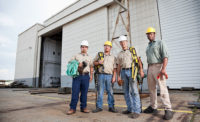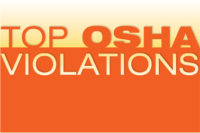Fall Protection – Training Requirements (1926.503) was the eighth most-frequently cited agency standard in FY 2019.
Enforcement citations FY 2019: 1,955
Number of inspections: 1,899
Proposed penalties: $2,953,334
Most frequently cited industries:
Construction industry employers filled the top three categories of most-cited industries for violations of this standard. Specialty Trade Contractors’ workplaces/operations were inspected 1,717 times and cited for 1,765 violations, with proposed penalties totaling $2,696,616. Next came Construction of Buildings employers, with 145 citations, 137 inspections and $223,642 in penalties.
Merchant Wholesalers, Durable Goods companies received 13 citations, were inspected 13 times and had penalties of $17,884. In fifth place: Administrative and Support Services, with five citations, five inspections and $4,000 in penalties. Utilities operations had three inspections, three citations and $0 in penalties, as did Fabricated Metal Product Manufacturing employers. Justice, Public Order, and Safety Activities, Heavy and Civil Engineering Construction, Waste Management and Remediation Services and Food Services and Drinking Places had identical citation and inspection statistics – two and two – with penalties of $4,641, $1,875, $569 and $0, respectively.
Why a standard?
Falls are the leading cause of death in the construction industry. In 2017, there were 366 fatal falls to a lower level out of 971 construction fatalities, according to Bureau of Labor Statistics (BLS) data.
Falls one of the most common causes of serious work-related injuries and deaths in many other industries as well.1
Employers are responsible for ensuring that workplaces are designed to prevent employees from falling off overhead platforms, off elevated work stations or into holes in the floor and walls. They must also provide appropriate fall protection, when necessary. However, if workers do not know how to correctly use fall protection, it will not effectively reduce their risk of being injured – or worse – in a workplace fall. That’s why workers must be trained about fall hazards and the proper use of fall protection – and in a language that they can understand.
Key provisions of the standard
The employer must provide a training program for each employee who might be exposed to fall hazards.
The program shall enable each employee to recognize the hazards of falling and shall train each employee in the procedures to be followed in order to minimize these hazards.
Training will be conducted by a competent person and will include: the nature of fall hazards in the work area; the correct procedures for erecting, maintaining, disassembling, and inspecting the fall protection systems to be used; the use and operation of guardrail systems, personal fall arrest systems, safety net systems, warning line systems, safety monitoring systems, controlled access zones, and other protection to be used and the role of each employee in the safety monitoring system when this system is used.
Depending upon the work being performed, training must also include the limitations on the use of mechanical equipment during the performance of roofing work on low-sloped roofs and the correct procedures for the handling and storage of equipment and materials and the erection of overhead protection.
The employer must verify compliance with the training requirements by preparing a written certification record which contains the name or other identity of the employee trained, the date(s) of the training, and the signature of the person who conducted the training or the signature of the employer. If the employer relies on training conducted by another employer or completed prior to the effective date of this section, the certification record shall indicate the date the employer determined the prior training was adequate rather than the date of actual training.
“Retraining” must be done when the employer has reason to believe that any affected employee who has already been trained does not have the understanding and skill required by the standard. Circumstances where retraining is required include, but are not limited to, situations where: changes in the workplace render previous training obsolete; changes in the types of fall protection systems or equipment to be used render previous training obsolete; or inadequacies in an affected employee's knowledge or use of fall protection systems or equipment indicate that the employee has not retained the requisite understanding or skill.
Assistance with training
OSHA has numerous resources available to help employers train workers in hazard recognition and the care and safe use of equipment such as ladders and scaffolds, and fall protection systems. These include posters, fact sheets and other materials2 that can be used during toolbox talks and other opportunities.
OSHA, in partnership with the National Institute for Occupational Safety and Health and National Occupational Research Agenda (NORA) - Construction Sector, has a three step campaign to prevent falls in construction:
- PLAN ahead to get the job done safely. This includes determining what safety equipment is needed for each task. When estimating the cost of a job, employers should include safety equipment, and plan to have all the necessary equipment and tools available at the construction site. For example, in a roofing job, think about all of the different fall hazards, such as holes or skylights and leading edges, then plan and select fall protection suitable to that work, such as personal fall arrest systems (PFAS).
- PROVIDE the right equipment. Employers must provide fall protection and the right equipment for the job, including the right kinds of ladders, scaffolds, and safety gear. For roof work, if workers use personal fall arrest systems (PFAS), provide a harness for each worker who needs to tie off to the anchor. Make sure the PFAS fits, and regularly inspect it for safe use.
- TRAIN everyone to use the equipment safely. Every worker should be trained on proper set-up and safe use of equipment they use on the job.
Compliance assistance3
- Prevention Videos (v-Tools) about falls in construction, floor openings, fixed scaffolds, skylights and more.
- OSHA Alliance Program Toolbox talks and Training product
- OSHA Fall Prevention Training Guide - A Lesson Plan for Employers. In English and Spanish.
- OSHA Scaffold eTool includes illustrated safety checklists for specific types of scaffolds.
References
- https://tinyurl.com/hgqge37
- https://tinyurl.com/tjxlvxz
- https://www.osha.gov/stopfalls/trainingresources.html
|
2020 Top Standards Article Index ANSI/ISEA 121- Dropped object prevention solutions NFPA 652 standard on fundamentals of combustible dust OSHA most frequently violated standardsFall protection- General Requirements (1926.501) Hazard Communication (1910.1200) The Control of Hazardous Energy (Lockout/Tagout) 1910.147 Respiratory Protection (1910.134) Powered Industrial Trucks (1910.178) |



